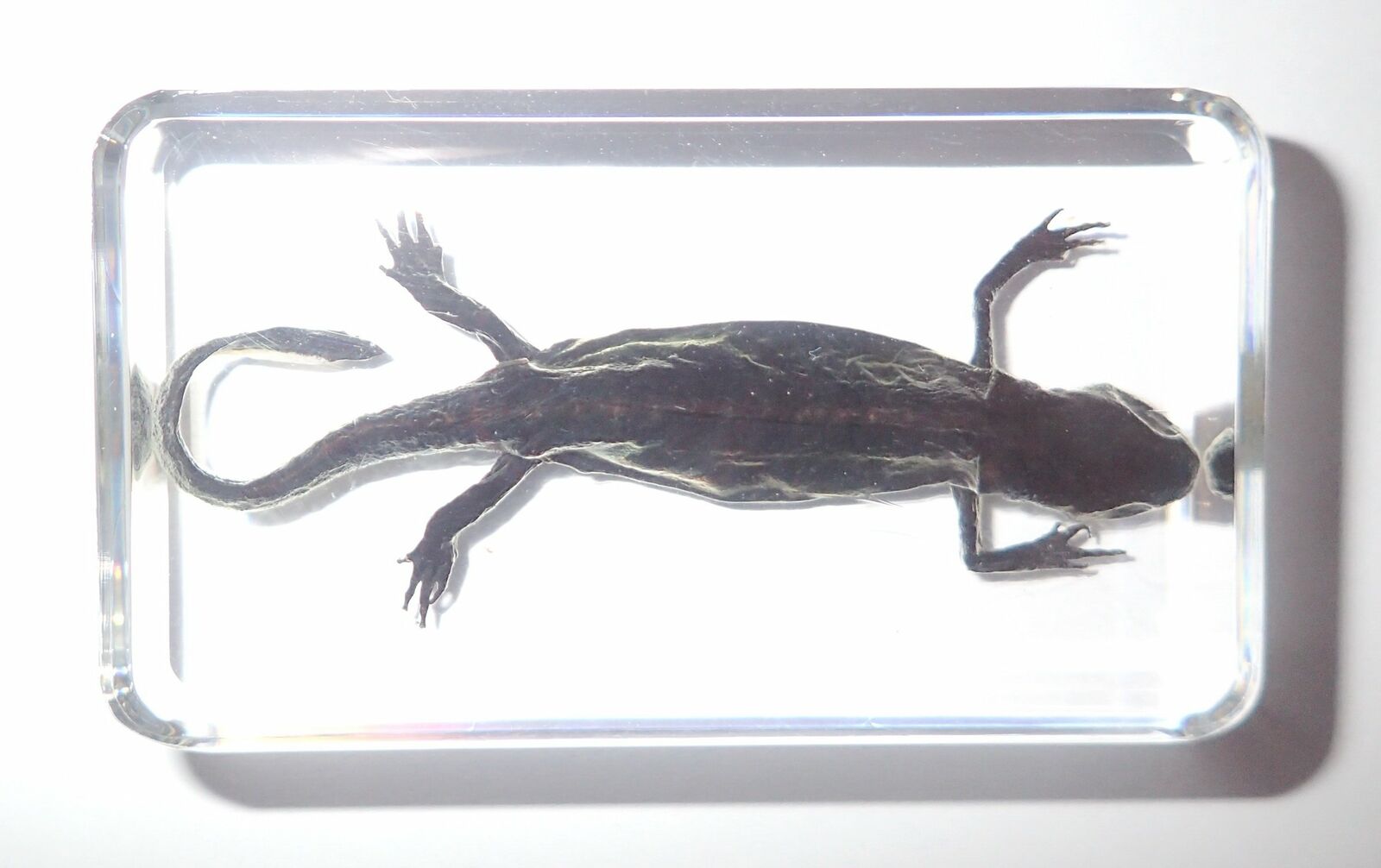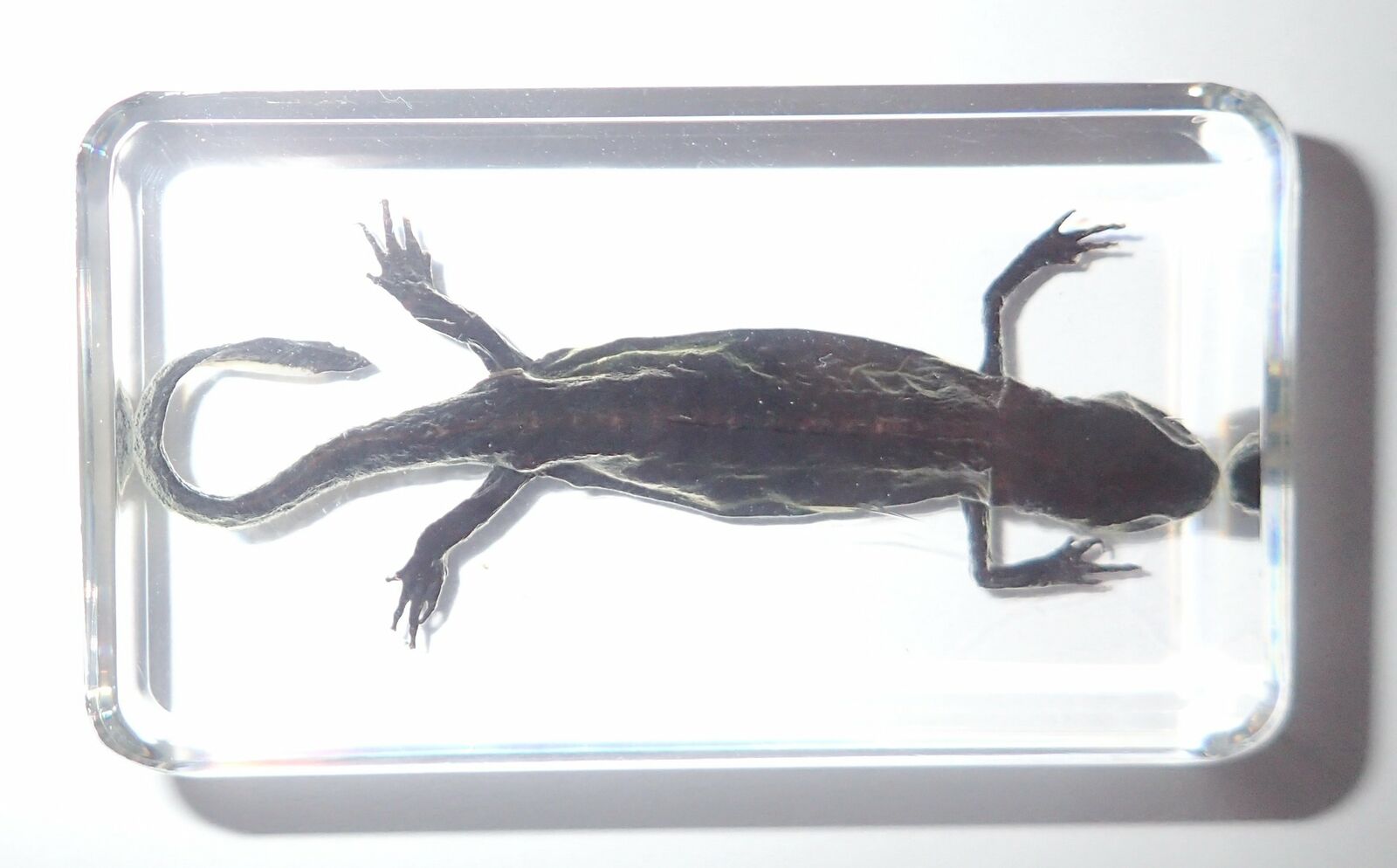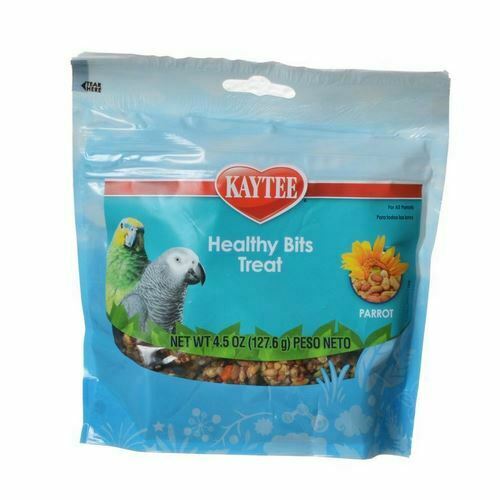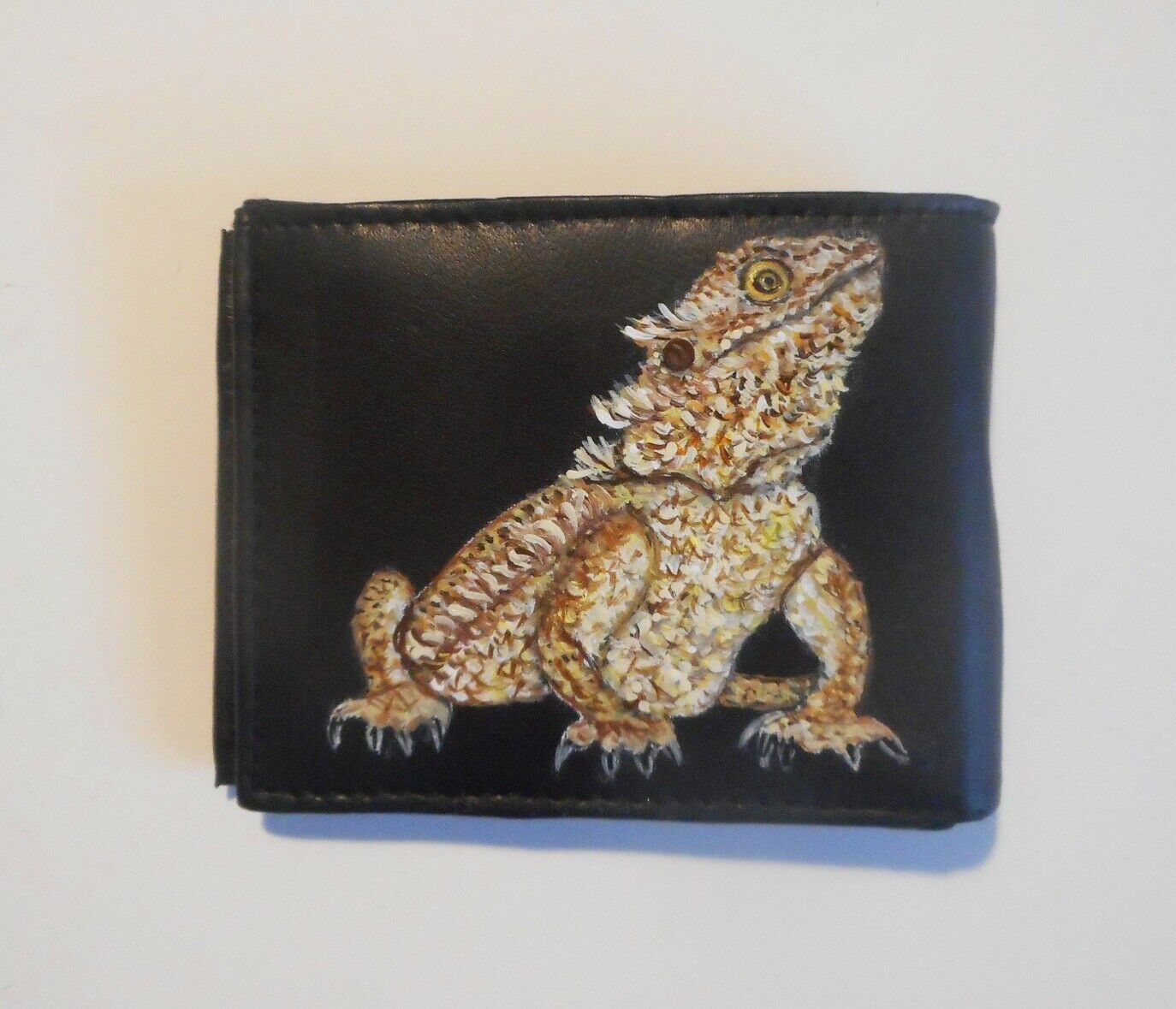-40%
Salamander Specimen Oriental Fire Belly Newt in Clear Block Education Aid
$ 8.44
- Description
- Size Guide
Description
Real Oriental Fire Belly Newt - Cynops orientalis specimen encased in our proprietary developed lucite material. The specimen is crystal clear, indestructible and transparent. Safe, authentic and completely unbreakable specimen put real Newt right at your fingertips! Anyone can safely explore the Newt from every angle.It is clear enough for microscope observation.
Length of the Newt from head to tail is 6.0 cm(2.4 inch).
Size of the lucite block is 7.3x4.1x1.5 cm(2.9x1.6x0.6 inch).
Each one comes with a cardboard box for easy storage.
Weight of the lucite block is 110 g and 140 g with packing box.
Nature & Science
https://stores.ebay.com/Gao-Fu-Collectibles
Salamander Specimen Oriental Fire Belly Newt in clear Block Education Aid
Real
Oriental Fire Belly Newt -
Cynops orientalis
specimen encased in our proprietary developed lucite material. The specimen is crystal clear, indestructible and transparent. Safe, authentic and completely unbreakable specimen put real Newt right at your fingertips! Anyone can safely explore the Newt from every angle.
It is clear enough for microscope observation.
Length of the Newt from head to tail is 6.0 cm(2.4 inch).
Size of the lucite block is 7.3x4.1x1.5 cm(2.9x1.6x0.6 inch).
Each one comes with a cardboard box for easy storage.
Weight of the lucite block is 110 g and 140 g with packing box.
It is an ideal learning aid for students and kids and also a very good collectible item for every body.
This is a handmade real animal specimen craft. Each one will be a bit different (specimen size, color and posture) even in the same production batch.
The picture in the listing is just for reference as we are selling multiple pieces with the same picture.
***
Oriental Fire Belly Newt -
Cynops orientalis
Class: Amphibia Order: Caudata
Family: Salamandridae
Genus:
Cynops
Species:
C. orientalis
Description
The Chinese Fire-bellied Newt is the smallest species of the East Asian salamandrid genus
Cynops
. In its morphological features this species is distinctly different from other taxa in this genus. Head relatively large, a little longer than broad; snout rounded. Palatine teeth in two longitudinal series, commencing from front of choanae meeting anteriorly, gradually diverging posteriorly. Tongue small, practically free at the sides. Paratoids moderately developed, their posterior borders demarcating head from neck. Faint vertebral ridge. Tail rather short, approximately the length of the body. Margins of dorsal and ventral tail fins nearly parallel in breeding male, ending rather abruptly in a rounded, blunt tip. Skin rather smooth, especially in aquatic individuals. Lateral line organs clearly discernible in water.
Male smaller than female, especially the tail is shorter in the male than in the female. In the reproductive season, males have well developed dorsal and ventral tail fins, and a swollen cloaca.
Colour is dark-brown to black above, occasionally greyish. Colour of belly and throat lively red or orange with many rounded black spots. The base of each limb, anterior part of the cloaca and ventral tail fin are orange, posterior part of cloaca is black.
Total maximum length 7 to 9 cm.
Eggs and larvae
Eggs are laid individually, under and between leaves, folded in a leaf, in floating roots and grasses. Size of oval-shaped jelly mass 4 to 2.5 mm, egg rounded, 2 mm in diameter. A female can lay a little over 100 eggs per season on average, from March to mid-June. Optimal water temperature for egg deposition is 15 to 23° C. Eggs laid in water of 18-25° hatch in 11 to 17 days, at lower temperatures hatching takes considerably longer.
One insemination is sufficient for a female to lay fertilized eggs during two months; in this and other features of oviposition and early development there are differences between
C. orientalis
and
C. cyanurus
.
Hatching larvae are 10-12 mm. Larvae are uniformly dark-brown to black, a little lighter on the ventral side, and take approximately 50 to 80 days to metamorphose. After metamorphosis at a length of 30-35 mm, juveniles live on land.
Distribution
C. orientalis
is widely distributed at the lower reach of the Yangtze River and adjacent areas, in the hilly plains of central and southeastern China at 30 to 1,500 m altitude (the provinces of Henan, southern Hubei, southern Anhui, Jiangsu, Zhejiang, Guangxi, Fujian, and Hunan).
Habitat
The habitat is described as consisting of all suitable water bodies at various altitudes, mountain ponds, seepages and paddy fields in hilly areas, small brooks, flooded fields in mountain valleys, in forests and degraded areas. Locally it may be very abundant. “Always the water is cold and quiet, in the shade of grass, with a mud bottom free from stones”. For egg deposition
C. orientalis
often chooses lentic water bodies such as ponds, wells and farmland ditches.
Behaviour
There are no studies in western languages on natural history and ecology of this species. Although the newts are often aquatic, they also live on land outside the breeding season. In Zhejiang where winters are mild,
C. orientalis
does not hibernate and can be found all year round. According to observations by Yang & Shen in Hunan (1993), males enter the breeding pond first in January and February, resulting in an initial sex-ratio eschewed towards males. Fei
et al
. (2006) refer to a peak in the breeding season from late April to mid May. Males and females leave the breeding water from July to September.
Reproduction and courtship behaviour is similar to that of other
Cynops
species, but shows temporal differences. The male identifies a female by sniffing her body. He positions himself in front of her, and rapidly vibrates the distal part of his tail, fanning towards her snout. If the female is responsive, she stays still or moves towards the male. The male then turns round, creeping ahead of the female. He deposits a spermatophore on the substrate and the female picks it up with her cloaca. The male’s tail-fanning courtship display and creep movements ahead of the female are of relatively short duration and one spermatophore is deposited a few seconds after the male starts to creep ahead of the female. The female looses interest in the male soon after the first spermatophore deposition. The male may bite and hold on to the female for a short while afterwards.
Threats and conservation
Given the local abundance of this species and its large distribution, the Chinese Fire-bellied Newt is not immediately endangered. Habitat destruction and degradation are major threats to this species, as well as the use of herbicides and insecticides on rice terraces. The animals are sold by the thousands in pet-markets in China and Europe.
Observations in captivity
This species has been successfully kept and bred in captivity. It can be kept aquatic all year round. Most observations on its behaviour were made in aquariums. It prefers dense vegetation and still water and takes all sorts of living and dead food items. In captivity juveniles can be persuaded to live in water, where they grow faster than on land.
Item Specifics
Type
Collector Plate
Material
Resin
Country/Region of Manufacture
China
Country of Manufacture
China
UPC
Does not apply
Payment
Payment: By Paypal
Shipping cost
Free shipping cost.
We send the goods to USA, Canada, UK, Australia, New Zealand, EU countries and some other European and Asian countries by E-express, a kind of fast postal service by Hong Kong Post. It usually takes about 6 to 10 working days for delivery.
We send the goods to other countries by registered airmail and will take about 8 to 14 working days for delivery.
Return policy
Returns: We accept returns with any reason in 30 days.
Messages
We will answer buyer messages within 24 hours during working days.
Nature & Science
https://stores.ebay.com/Gao-Fu-Collectibles
Shop Category
Store Home
Insect & Animal
◈ Magnet
◈ Stapler
▷ Bracelet
♢ Transparent Clear
♢ Glow in the Dark
▷ Pendant/Necklace
♢ Clear
♢ Glow
◈ Table Display
◈ Bangle
▷ Sphere
♢ 2 cm
♢ 5 - 6 cm
♢ 7.5 - 8.5 cm
♢ Shift Knob
◈ Ring
▷ Hanger / Cell Phone Charm
♢ Clear
♢ Glow
◈ Dome paperweight
◈ Animal Skeleton
◈ Life Cycle
◈ Butterfly
▷ Scorpion
♢ Golden Scorpion
♢ Black Scorpion
♢ Other Scorpion
▷ Spider
♢ Tarantula Spider
♢ Other Spiders
♢ Spiny Spider
▷ Insect specimen - Beetle
♢ Ladybird Beetle
♢ Unicorn Beetle
♢ Dung Beetle
♢ Rose Chafer Beetle
♢ Snout Beetle
♢ Stag Beetle
♢ Longhorn Beetle
♢ Scarab Beetle
♢ Others
♢ Ground Beetle
♢ Leaf Beetle
◈ Collection Set
▷ Keychain
♢ Clear
♢ Glow in the dark
◈ Centipede
▷ Snake
♢ Snake
♢ Snake Skeleton
◈ Labelled specimen
▷ Marine Animal
♢ Crab
♢ Seahorse
♢ Starfish
♢ Coral
♢ Turtle
♢ Shrimp / Prawn
♢ Other sea animal
◈ Computer Mouse
◈ Ashtray
▷ Cabochon
♢ Round - 35 mm / 36 mm
♢ Oval - 18x25 mm
♢ Oval - 30x40 mm
♢ Others
♢ Oval - 12x18 mm
♢ Round 23.5 mm / 25 mm
♢ Round 38.5 mm
♢ Round 38 mm
♢ Round 19 mm
♢ Round 13 mm
◈ Insect Pen
◈ Locust / Grasshopper
◈ Bee / Wasp / Hornet
◈ Bottle Opener
◈ Bugs
◈ Other animals
◈ Ant
◈ Cicada
◈ Other insects
Jewelry items
◈ Cabochon
Framed specimens
Shark Teeth
◈ Shark Tooth Keychain
◈ Necklace / Bracelet
Flower,plant
▷ Leaf
♢ Labelled specimen
♢ Leaf
◈ Flower
◈ Bean/Seed/Nut
◈ Life cycle
◈ Root
◈ Collection set
◈ Laminated Specimen
Paper Cuts
◈ Large Set
▷ Small Set
♢ Year of Animals/Zodiac Animals
♢ Butterfly
♢ Animals
♢ People/Figures
♢ Flower
♢ Scenery/Landscape
♢ Fortune Item
♢ Decoration Item
♢ Animal -- Horse
♢ Animal -- Bird
♢ Animal -- Fish
♢ Animal -- Cow
♢ Animal -- Panda
♢ Animal -- Dragon
♢ Animal -- Snake
♢ Animal -- Monkey
♢ Animal -- Chicken
♢ Animal -- Insect
♢ Animal - Mouse
♢ Animal -- Cat
◈ Single Piece
▷ Heros of Water Margin
♢ Single Piece
♢ Whole Set & Sub Sets
◈ Bookmark
Star Ruby & Sapphire
▷ Ruby -- Opaque Cabochon
♢ Oval
♢ Heart
♢ Round
♢ Square
♢ Pear
♢ Marquise
♢ Triangular
▷ Ruby -- Transparent Cabochon
♢ Oval
♢ Round
♢ Heart
▷ Sapphire -- Opaque Blue Cab
♢ Oval
♢ Heart
♢ Round
♢ Pear
♢ Marquise
♢ Square
◈ Sapphire--Transparent Orange
◈ Sapphire -- Opaque White Cab
◈ Sapphire -- Transparent Purple
◈ Sapphire -- Transparent Yellow
◈ Jewelry items
Fossils
▷ Trilobites
♢ Ductina vietnamica
♢ Coronocephalus jastrowi
♢ Arthricocephalus granulus
♢ Redlichia chinensis
◈ Plants
◈ Seashell / Sea Animals
◈ Insect
◈ Animal tooth
◈ Coral
Lapis Lazuli Stone
▷ Rough Stone
♢ Polished Stone
♢ Unpolished Rough Stone
◈ Cabochon
◈ Carvings
Stone Carving
◈ Lapis Lazuli Stone
◈ Other stone
◈ Tiger Eye Stone
◈ Quartz
Mineral, crystal, gemstone
◈ Kunzite Rough Stone
◈ Cinnabar Specimen
◈ Ruby stone
◈ Desert Agate
◈ Aquamarine
◈ Pyrite
▷ Jasper stone
♢ Red Jasper
♢ Desert Jasper
◈ Amazonite
◈ Sapphire stone
◈ Epidote
▷ Clear Quartz Crystal
♢ Rough crystal
▷ Tiger Eye Stone
♢ Polished stone
♢ Carvings
▷ Agate
♢ Agate stone specimen
◈ Garnet
◈ Other stones
◈ Opal
◈ Tourmaline
◈ Fluorite
◈ Moonstone
◈ Jadeite Stone
◈ Stone Mix - Collection Set
◈ Citrine
◈ Amethyst
◈ Prehnite
◈ Peridot
◈ Topaz
Meteorite & Tektite, Moldavite
▷ Black Tektite
♢ Rough stone specimen
♢ Pendant
♢ Cell phone strap
Turquoise
▷ Turquoise substitute stone
♢ Rough stone
◈ Cabochon
Fish items
◈ Fish specimen
◈ Fish skeleton
◈ Fish keychain
Bookmark
▷ Butterfly on the leaf
♢ Laminated - small
Hot Item
Large Tarantula Spider Golden Earth Tiger 110x43x30 mm Block Education Specimen
USD 20.00
Chinese Paper Cuts 8 Flying Butterfly Set 8 Small Colorful Pieces 1 packet Lot
USD 10.00
Paper Cuts Dragon Set 8 colorful small single pieces CHEN 1 packet Lot
USD 10.00
Natural Ruby Rough Stone 0.4 to 4 g Small Nugget from Tanzania 70 gram Lot
USD 15.00
Powdered Cinnabar Crystal Native Pigment Material 50 gram Lot
USD 20.00
New List Item
Turquoise Stone Pear 22x14 mm Flat Cabochon 125 Carat 12 pieces 25 gram
USD 30.99
Turquoise Stone Pear 24x16 mm Flat Cabochon 116.5 Carat 9 pieces 23.3 gram
USD 28.99
Polished Red Agate Stone 0.5 to 2 g Very Small size pieces 400 gram Lot
USD 21.99
Large Clear Key Ring Common Octopus SK12 Octopus vulgaris Specimen
USD 14.99
Turquoise Stone Flat Free Form Cabochon 145 Carat 2 pieces 29 gram Lot D
USD 22.99
Picture
Custom Item
Salamander Specimen Oriental Fire Belly Newt in clear Block Education Aid
Real
Oriental Fire Belly Newt -
Cynops orientalis
specimen encased in our proprietary developed lucite material. The specimen is crystal clear, indestructible and transparent. Safe, authentic and completely unbreakable specimen put real Newt right at your fingertips! Anyone can safely explore the Newt from every angle.
It is clear enough for microscope observation.
Length of the Newt from head to tail is 6.0 cm(2.4 inch).
Size of the lucite block is 7.3x4.1x1.5 cm(2.9x1.6x0.6 inch).
Each one comes with a cardboard box for easy storage.
Weight of the lucite block is 110 g and 140 g with packing box.
It is an ideal learning aid for students and kids and also a very good collectible item for every body.
This is a handmade real animal specimen craft. Each one will be a bit different (specimen size, color and posture) even in the same production batch.
The picture in the listing is just for reference as we are selling multiple pieces with the same picture.
***
Oriental Fire Belly Newt -
Cynops orientalis
Class: Amphibia Order: Caudata
Family: Salamandridae
Genus:
Cynops
Species:
C. orientalis
Description
The Chinese Fire-bellied Newt is the smallest species of the East Asian salamandrid genus
Cynops
. In its morphological features this species is distinctly different from other taxa in this genus. Head relatively large, a little longer than broad; snout rounded. Palatine teeth in two longitudinal series, commencing from front of choanae meeting anteriorly, gradually diverging posteriorly. Tongue small, practically free at the sides. Paratoids moderately developed, their posterior borders demarcating head from neck. Faint vertebral ridge. Tail rather short, approximately the length of the body. Margins of dorsal and ventral tail fins nearly parallel in breeding male, ending rather abruptly in a rounded, blunt tip. Skin rather smooth, especially in aquatic individuals. Lateral line organs clearly discernible in water.
Male smaller than female, especially the tail is shorter in the male than in the female. In the reproductive season, males have well developed dorsal and ventral tail fins, and a swollen cloaca.
Colour is dark-brown to black above, occasionally greyish. Colour of belly and throat lively red or orange with many rounded black spots. The base of each limb, anterior part of the cloaca and ventral tail fin are orange, posterior part of cloaca is black.
Total maximum length 7 to 9 cm.
Eggs and larvae
Eggs are laid individually, under and between leaves, folded in a leaf, in floating roots and grasses. Size of oval-shaped jelly mass 4 to 2.5 mm, egg rounded, 2 mm in diameter. A female can lay a little over 100 eggs per season on average, from March to mid-June. Optimal water temperature for egg deposition is 15 to 23° C. Eggs laid in water of 18-25° hatch in 11 to 17 days, at lower temperatures hatching takes considerably longer.
One insemination is sufficient for a female to lay fertilized eggs during two months; in this and other features of oviposition and early development there are differences between
C. orientalis
and
C. cyanurus
.
Hatching larvae are 10-12 mm. Larvae are uniformly dark-brown to black, a little lighter on the ventral side, and take approximately 50 to 80 days to metamorphose. After metamorphosis at a length of 30-35 mm, juveniles live on land.
Distribution
C. orientalis
is widely distributed at the lower reach of the Yangtze River and adjacent areas, in the hilly plains of central and southeastern China at 30 to 1,500 m altitude (the provinces of Henan, southern Hubei, southern Anhui, Jiangsu, Zhejiang, Guangxi, Fujian, and Hunan).
Habitat
The habitat is described as consisting of all suitable water bodies at various altitudes, mountain ponds, seepages and paddy fields in hilly areas, small brooks, flooded fields in mountain valleys, in forests and degraded areas. Locally it may be very abundant. “Always the water is cold and quiet, in the shade of grass, with a mud bottom free from stones”. For egg deposition
C. orientalis
often chooses lentic water bodies such as ponds, wells and farmland ditches.
Behaviour
There are no studies in western languages on natural history and ecology of this species. Although the newts are often aquatic, they also live on land outside the breeding season. In Zhejiang where winters are mild,
C. orientalis
does not hibernate and can be found all year round. According to observations by Yang & Shen in Hunan (1993), males enter the breeding pond first in January and February, resulting in an initial sex-ratio eschewed towards males. Fei
et al
. (2006) refer to a peak in the breeding season from late April to mid May. Males and females leave the breeding water from July to September.
Reproduction and courtship behaviour is similar to that of other
Cynops
species, but shows temporal differences. The male identifies a female by sniffing her body. He positions himself in front of her, and rapidly vibrates the distal part of his tail, fanning towards her snout. If the female is responsive, she stays still or moves towards the male. The male then turns round, creeping ahead of the female. He deposits a spermatophore on the substrate and the female picks it up with her cloaca. The male’s tail-fanning courtship display and creep movements ahead of the female are of relatively short duration and one spermatophore is deposited a few seconds after the male starts to creep ahead of the female. The female looses interest in the male soon after the first spermatophore deposition. The male may bite and hold on to the female for a short while afterwards.
Threats and conservation
Given the local abundance of this species and its large distribution, the Chinese Fire-bellied Newt is not immediately endangered. Habitat destruction and degradation are major threats to this species, as well as the use of herbicides and insecticides on rice terraces. The animals are sold by the thousands in pet-markets in China and Europe.
Observations in captivity
This species has been successfully kept and bred in captivity. It can be kept aquatic all year round. Most observations on its behaviour were made in aquariums. It prefers dense vegetation and still water and takes all sorts of living and dead food items. In captivity juveniles can be persuaded to live in water, where they grow faster than on land.
Payment
Payment: By Paypal
Shipping cost
Free shipping cost.
We send the goods to USA, Canada, UK, Australia, New Zealand, EU countries and some other European and Asian countries by E-express, a kind of fast postal service by Hong Kong Post. It usually takes about 6 to 10 working days for delivery.
We send the goods to other countries by registered airmail and will take about 8 to 14 working days for delivery.
Return policy
Returns: We accept returns with any reason in 30 days.
Messages
We will answer buyer messages within 24 hours during working days.
Copy rights of https://stores.ebay.com/Gao-Fu-Collectibles. All right reserved.















